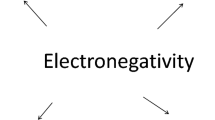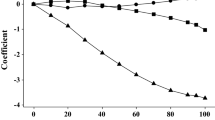Abstract
An atom/fragment contribution method that predicts log P is described. Coefficient values for 150 atom/fragments and 250 correction factors have been derived from a training set of 2473 compounds. When applied to an independent validation set of 10589 compounds, the method estimates log P with excellent accuracy (correlation coefficient r 2 of 0.943, standard deviation of 0.473, and absolute mean error of 0.354). A method that predicts water solubility from log P is also described.
Similar content being viewed by others
References
Hansch, C. and Leo, A., Exploring QSAR, Fundamentals and Applications in Chemistry and Biology, American Chemical Society, Washington, DC, 1995.
Lyman, W.J., In Lyman, W.J. and Rosenblatt (Eds.) Handbook of Chemical Property Estimation Methods: Environmental Behaviour of Organic Compounds, American Chemical Society, Washington, DC, 1990, Chapter 1.
Meylan, W.M. and Howard, P.H., J. Pharm. Sci., 84 (1995) 83.
Meylan, W.M. and Howard, P.H., Environ. Toxicol. Chem., 15 (1996) 100.
Hansch, C., Leo, A. and Hoekman, D., Exploring QSAR. Hydrophobic, Electronic, and Steric Constants, ACS Professional Reference Book. American Chemical Society, Washington, DC, 1995.
Sangster, J., LOGKOWDatabank. A databank of evaluated octanol—water partition coef-ficients (log P) on microcomputer diskette, Sangster Research Laboratories, Montreal, PQ, Canada, 1994.
PHYSPROP©Database, Syracuse Research Corporation, North Syracuse, NY, available in ISISTM/Base (MDL Information Systems Inc.), Microsoft Excel, plain text and other formats.
Yalkowsky, S.H. and Dannenfelser, R.M., AQUASOL Database of Aqueous Solubility, 5th ed., University of Arizona, College of Pharmacy, Tucson, AZ, 1992.
KowSrc Database. Syracuse Research Corporation, North Syracuse, NY, available in ISISTM/Base (MDL Information Systems Inc.), Microsoft Excel, plain text and other formats.
ClogP, BioByte Corporation, Claremont, CA.
The Merck Index, An Encyclopedia of Chemicals, Drugs, and Biologicals, 11th ed., Merck & Co. Inc., Rahway, NJ, 1989.
Beilstein Institute for Organic Chemistry, Beilstein On-Line, Springer-Verlag Electronic Information Services, New York, NY, 1994.
Howard, P.H., Sage, G.W., LaMacchia, A. and Colb, A., J. Chem. Inf. Comput. Sci., 22 (1982) 38.
Lide, D.R. (Editor-in-chief), CRC Handbook of Chemistry and Physics, 71st ed., CRC Press, Boca Raton, FL, 1990.
Aldrich, Aldrich Catalog Handbook of Fine Chemicals, Aldrich Chemical Co. Inc., Milwaukee, WI, 1992.
Weininger, D., J. Chem. Inf. Comput. Sci., 28 (1988) 31.
KOWWIN© and WSKOWWIN© Programs, Syracuse Research Corporation, North Syracuse, NY (tel.: 315-452-8417; fax: 315-452-8440; web-site: http://esc.syrres.com).
Author information
Authors and Affiliations
Corresponding author
Rights and permissions
About this article
Cite this article
Meylan, W.M., Howard, P.H. Estimating log P with atom/fragments and water solubility with log P. Perspectives in Drug Discovery and Design 19, 67–84 (2000). https://doi.org/10.1023/A:1008715521862
Issue Date:
DOI: https://doi.org/10.1023/A:1008715521862




